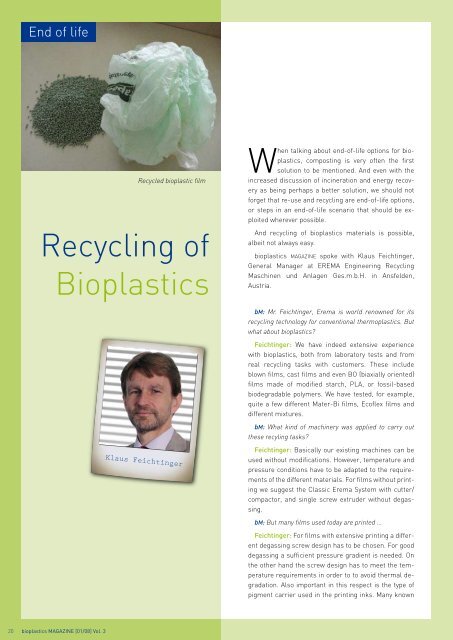01 | 2008
You also want an ePaper? Increase the reach of your titles
YUMPU automatically turns print PDFs into web optimized ePapers that Google loves.
End of life<br />
Recycled bioplastic film<br />
Recycling of<br />
Bioplastics<br />
When talking about end-of-life options for bioplastics,<br />
composting is very often the first<br />
solution to be mentioned. And even with the<br />
increased discussion of incineration and energy recovery<br />
as being perhaps a better solution, we should not<br />
forget that re-use and recycling are end-of-life options,<br />
or steps in an end-of-life scenario that should be exploited<br />
wherever possible.<br />
And recycling of bioplastics materials is possible,<br />
albeit not always easy.<br />
bioplastics MAGAZINE spoke with Klaus Feichtinger,<br />
General Manager at EREMA Engineering Recycling<br />
Maschinen und Anlagen Ges.m.b.H. in Ansfelden,<br />
Austria.<br />
bM: Mr. Feichtinger, Erema is world renowned for its<br />
recycling technology for conventional thermoplastics. But<br />
what about bioplastics?<br />
Feichtinger: We have indeed extensive experience<br />
with bioplastics, both from laboratory tests and from<br />
real recycling tasks with customers. These include<br />
blown films, cast films and even BO (biaxially oriented)<br />
films made of modified starch, PLA, or fossil-based<br />
biodegradable polymers. We have tested, for example,<br />
quite a few different Mater-Bi films, Ecoflex films and<br />
different mixtures.<br />
bM: What kind of machinery was applied to carry out<br />
these recyling tasks?<br />
Klaus Feichtinger<br />
Feichtinger: Basically our existing machines can be<br />
used without modifications. However, temperature and<br />
pressure conditions have to be adapted to the requirements<br />
of the different materials. For films without printing<br />
we suggest the Classic Erema System with cutter/<br />
compactor, and single screw extruder without degassing.<br />
bM: But many films used today are printed ...<br />
Feichtinger: For films with extensive printing a different<br />
degassing screw design has to be chosen. For good<br />
degassing a sufficient pressure gradient is needed. On<br />
the other hand the screw design has to meet the temperature<br />
requirements in order to to avoid thermal degradation.<br />
Also important in this respect is the type of<br />
pigment carrier used in the printing inks. Many known<br />
20 bioplastics MAGAZINE [<strong>01</strong>/08] Vol. 3


















